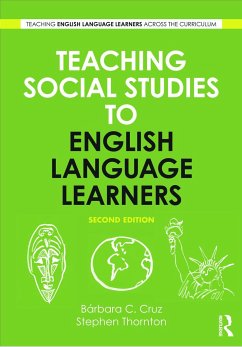- Broschiertes Buch
- Merkliste
- Auf die Merkliste
- Bewerten Bewerten
- Teilen
- Produkt teilen
- Produkterinnerung
- Produkterinnerung
Teaching Social Studies to English Language Learners provides readers with a comprehensive understanding of both the challenges that face English language learners (ELLs) and ways in which educators might address them in the social studies classroom.
Andere Kunden interessierten sich auch für
![Teaching Mathematics to English Language Learners Teaching Mathematics to English Language Learners]() Gladis KersaintTeaching Mathematics to English Language Learners67,99 €
Gladis KersaintTeaching Mathematics to English Language Learners67,99 €![Teaching Social Studies to English Language Learners Teaching Social Studies to English Language Learners]() Barbara C. Cruz (USA University of South Florida)Teaching Social Studies to English Language Learners57,99 €
Barbara C. Cruz (USA University of South Florida)Teaching Social Studies to English Language Learners57,99 €![Practical Grammar Teaching for the Second Language Classroom Practical Grammar Teaching for the Second Language Classroom]() Practical Grammar Teaching for the Second Language Classroom37,99 €
Practical Grammar Teaching for the Second Language Classroom37,99 €![English Literacy Educators Working with Refugee Families English Literacy Educators Working with Refugee Families]() English Literacy Educators Working with Refugee Families53,99 €
English Literacy Educators Working with Refugee Families53,99 €![Teaching Essential Units of Language Teaching Essential Units of Language]() Teaching Essential Units of Language172,99 €
Teaching Essential Units of Language172,99 €![Teaching Communication, Skills and Competencies for the International Workplace Teaching Communication, Skills and Competencies for the International Workplace]() Julio GimenezTeaching Communication, Skills and Competencies for the International Workplace42,99 €
Julio GimenezTeaching Communication, Skills and Competencies for the International Workplace42,99 €![Family Language Policy in the Polish Diaspora Family Language Policy in the Polish Diaspora]() Piotr RomanowskiFamily Language Policy in the Polish Diaspora195,99 €
Piotr RomanowskiFamily Language Policy in the Polish Diaspora195,99 €-
-
-
Teaching Social Studies to English Language Learners provides readers with a comprehensive understanding of both the challenges that face English language learners (ELLs) and ways in which educators might address them in the social studies classroom.
Produktdetails
- Produktdetails
- Teaching English Language Learners across the Curriculum
- Verlag: Taylor & Francis Ltd
- 2 ed
- Seitenzahl: 262
- Erscheinungstermin: 11. März 2013
- Englisch
- Abmessung: 254mm x 178mm x 15mm
- Gewicht: 486g
- ISBN-13: 9780415634960
- ISBN-10: 0415634962
- Artikelnr.: 36595888
- Herstellerkennzeichnung
- Libri GmbH
- Europaallee 1
- 36244 Bad Hersfeld
- gpsr@libri.de
- Teaching English Language Learners across the Curriculum
- Verlag: Taylor & Francis Ltd
- 2 ed
- Seitenzahl: 262
- Erscheinungstermin: 11. März 2013
- Englisch
- Abmessung: 254mm x 178mm x 15mm
- Gewicht: 486g
- ISBN-13: 9780415634960
- ISBN-10: 0415634962
- Artikelnr.: 36595888
- Herstellerkennzeichnung
- Libri GmbH
- Europaallee 1
- 36244 Bad Hersfeld
- gpsr@libri.de
Stephen J. Thornton is Professor and Chair of the Department of Secondary Education at the University of South Florida, USA. Bárbara C. Cruz is Professor of Social Science Education at the University of South Florida, USA.
PART ONE: YOUR ENGLISH LANGUAGE LEARNER
By Tony Erben
1. The Process of English Language Learning and What to Expect
2. Different Types of ESOL Programs: Descriptions and Expectations
3. First Language Development and Development in English
4. Not All ELLs are the same
5. Troubleshooting: Specific Issues and Challenges
PART TWO: WHAT WE KNOW FROM RESEARCH
6. Principles of Social Studies Learning and Research
7. Social Studies-focused ESOL Research
8. Listening, Speaking, Reading, and; Writing
9. Language Acquisition
10. Bilingual Special Needs
PART THREE: TEACHING SOCIAL STUDIES
11. Introduction
12. Courses in Social Studies
Geography
U.S. History
World History
Government and Civics
Economics
Sociology, Anthropology, and Psychology
13. Controversial Issues in the Social Studies Classroom
PART FOUR: ANNOTATED RESOURCES
PART ONE: YOUR ENGLISH LANGUAGE LEARNER
1.1 Orientation
1.2 The Process of English Language Learning and What to Expect
1.3 Deciding on the Best ESOL Program
1.4 Teaching for English Language Development
1.5 Not All ELLs are the same
1.6 Culturally Responsive Pedagogy
1.7 Not All Parents are the Same: Home-School Communication
1.8 English Language Learners with Special Needs
PART TWO: PRINCIPLES OF SOCIAL STUDIES TEACHING AND LEARNING
2.1 Principles of Social Studies Teaching and Learning
2.2 How Instruction Unfolds
2.3 Social Studies-focused ESOL Research
2.4 Enacting the Social Studies Curriculum
PART THREE: TEACHING SOCIAL STUDIES
3.1 Introduction
3.2 Geography
3.3 U.S. History
3.4 World History
3.5 Government and Civics
3.6 Economics
3.7 Sociology, Anthropology, and Psychology
3.8 Controversial Issues in the Social Studies Classroom
PART FOUR: ANNOTATED RESOURCES
By Tony Erben
1. The Process of English Language Learning and What to Expect
2. Different Types of ESOL Programs: Descriptions and Expectations
3. First Language Development and Development in English
4. Not All ELLs are the same
5. Troubleshooting: Specific Issues and Challenges
PART TWO: WHAT WE KNOW FROM RESEARCH
6. Principles of Social Studies Learning and Research
7. Social Studies-focused ESOL Research
8. Listening, Speaking, Reading, and; Writing
9. Language Acquisition
10. Bilingual Special Needs
PART THREE: TEACHING SOCIAL STUDIES
11. Introduction
12. Courses in Social Studies
Geography
U.S. History
World History
Government and Civics
Economics
Sociology, Anthropology, and Psychology
13. Controversial Issues in the Social Studies Classroom
PART FOUR: ANNOTATED RESOURCES
PART ONE: YOUR ENGLISH LANGUAGE LEARNER
1.1 Orientation
1.2 The Process of English Language Learning and What to Expect
1.3 Deciding on the Best ESOL Program
1.4 Teaching for English Language Development
1.5 Not All ELLs are the same
1.6 Culturally Responsive Pedagogy
1.7 Not All Parents are the Same: Home-School Communication
1.8 English Language Learners with Special Needs
PART TWO: PRINCIPLES OF SOCIAL STUDIES TEACHING AND LEARNING
2.1 Principles of Social Studies Teaching and Learning
2.2 How Instruction Unfolds
2.3 Social Studies-focused ESOL Research
2.4 Enacting the Social Studies Curriculum
PART THREE: TEACHING SOCIAL STUDIES
3.1 Introduction
3.2 Geography
3.3 U.S. History
3.4 World History
3.5 Government and Civics
3.6 Economics
3.7 Sociology, Anthropology, and Psychology
3.8 Controversial Issues in the Social Studies Classroom
PART FOUR: ANNOTATED RESOURCES
PART ONE: YOUR ENGLISH LANGUAGE LEARNER
By Tony Erben
1. The Process of English Language Learning and What to Expect
2. Different Types of ESOL Programs: Descriptions and Expectations
3. First Language Development and Development in English
4. Not All ELLs are the same
5. Troubleshooting: Specific Issues and Challenges
PART TWO: WHAT WE KNOW FROM RESEARCH
6. Principles of Social Studies Learning and Research
7. Social Studies-focused ESOL Research
8. Listening, Speaking, Reading, and; Writing
9. Language Acquisition
10. Bilingual Special Needs
PART THREE: TEACHING SOCIAL STUDIES
11. Introduction
12. Courses in Social Studies
Geography
U.S. History
World History
Government and Civics
Economics
Sociology, Anthropology, and Psychology
13. Controversial Issues in the Social Studies Classroom
PART FOUR: ANNOTATED RESOURCES
PART ONE: YOUR ENGLISH LANGUAGE LEARNER
1.1 Orientation
1.2 The Process of English Language Learning and What to Expect
1.3 Deciding on the Best ESOL Program
1.4 Teaching for English Language Development
1.5 Not All ELLs are the same
1.6 Culturally Responsive Pedagogy
1.7 Not All Parents are the Same: Home-School Communication
1.8 English Language Learners with Special Needs
PART TWO: PRINCIPLES OF SOCIAL STUDIES TEACHING AND LEARNING
2.1 Principles of Social Studies Teaching and Learning
2.2 How Instruction Unfolds
2.3 Social Studies-focused ESOL Research
2.4 Enacting the Social Studies Curriculum
PART THREE: TEACHING SOCIAL STUDIES
3.1 Introduction
3.2 Geography
3.3 U.S. History
3.4 World History
3.5 Government and Civics
3.6 Economics
3.7 Sociology, Anthropology, and Psychology
3.8 Controversial Issues in the Social Studies Classroom
PART FOUR: ANNOTATED RESOURCES
By Tony Erben
1. The Process of English Language Learning and What to Expect
2. Different Types of ESOL Programs: Descriptions and Expectations
3. First Language Development and Development in English
4. Not All ELLs are the same
5. Troubleshooting: Specific Issues and Challenges
PART TWO: WHAT WE KNOW FROM RESEARCH
6. Principles of Social Studies Learning and Research
7. Social Studies-focused ESOL Research
8. Listening, Speaking, Reading, and; Writing
9. Language Acquisition
10. Bilingual Special Needs
PART THREE: TEACHING SOCIAL STUDIES
11. Introduction
12. Courses in Social Studies
Geography
U.S. History
World History
Government and Civics
Economics
Sociology, Anthropology, and Psychology
13. Controversial Issues in the Social Studies Classroom
PART FOUR: ANNOTATED RESOURCES
PART ONE: YOUR ENGLISH LANGUAGE LEARNER
1.1 Orientation
1.2 The Process of English Language Learning and What to Expect
1.3 Deciding on the Best ESOL Program
1.4 Teaching for English Language Development
1.5 Not All ELLs are the same
1.6 Culturally Responsive Pedagogy
1.7 Not All Parents are the Same: Home-School Communication
1.8 English Language Learners with Special Needs
PART TWO: PRINCIPLES OF SOCIAL STUDIES TEACHING AND LEARNING
2.1 Principles of Social Studies Teaching and Learning
2.2 How Instruction Unfolds
2.3 Social Studies-focused ESOL Research
2.4 Enacting the Social Studies Curriculum
PART THREE: TEACHING SOCIAL STUDIES
3.1 Introduction
3.2 Geography
3.3 U.S. History
3.4 World History
3.5 Government and Civics
3.6 Economics
3.7 Sociology, Anthropology, and Psychology
3.8 Controversial Issues in the Social Studies Classroom
PART FOUR: ANNOTATED RESOURCES








